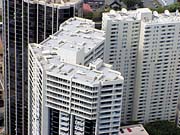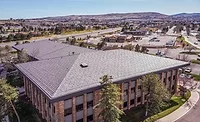Project Profile: Honolulu Park Place

The complex started its reroof process after a routine inspection revealed significant installation failures that resulted in water infiltration throughout the old system. "We realized that it was not a product failure but an installation problem with the flashing system and insulation," says Drew Camenson, general manager of Honolulu Park Place. "We decided that we needed help."
Camenson contacted Mike Smith of Smith Hawaii, a well-known roofing consultant on the island. After reviewing the failed roofing system, Smith recommended replacing it with either a torch-down system or a self-adhering built-up roofing system. He put the project out to bid, and ended up with five roofing contractors who were chosen to present to the condominium management.
"Mike Smith does things a little differently," says Chu. "He puts the job out to bid and then asks the contractors to make a presentation to the property management. The decision is not on the lowest bid but on who can do the job correctly."
In fact, MRC was not the low bidder, but won the bid because of its reputation. Smith left it up to MRC to choose which roofing system to use. Taking into consideration the fact that Honolulu Park Place is 41 stories high with impossible access and subject to high trade winds at the top of the building, Chu chose Polyglass' ADESOÔ Dual Compound Self-Adhesive built-up membranes, from a specified list of competitive products.
"As the roofing market has evolved, contractors have witnessed the emergence of several types of commercial roofing systems. But through the course of time, bituminous roofing has continued to take the largest strides forward," says John DeChandt, Western regional manager for Polyglass. "In contrast to other materials and plastics, bituminous roofing offers an unrivaled solution for waterproofing flat roofs. That is why the evolution to bituminous self adhesives is so impressive."
"One of the main advantages of ADESO is the lack of need for torch, mop or solvent-based adhesives due to the inherent self-adhering properties of the membranes," Chu says. "They stick easily to most surfaces with exceptional adhesion at joints. The end result is no noise, smell or open flame to upset tenants, which is a great asset for our company with property management groups."
"We hardly knew that MRC was here," says Camenson. "They developed a plan for loading the roof that worked great. The use of the self-adhesive roofing really made a difference in noise and smell."
Chu worked with Greg Clements from RoofMaster Products Co., Monterey Park, Calif., to develop a special cable and hoist system that would enable MRC to hoist the old roofing system's debris down from the roof and bring the new products up. "We were lifting materials 400 feet in the air and bringing down tear-off," Chu said. "It worked great. As always, we had a great emphasis on safety and with the help of Greg Clements we were able to engineer it so that it worked very efficiently."
Chu adds that there was no access from the outside, except with a hoist. "We did not want to carry tear-off and new roofing up and down stairs and elevators. We felt it would be to disruptive to tenants. Looking back it was a good thing considering the amount of tonnage we moved off the roof."
The old roofing system had failed throughout the flashing system and had been absorbing water into the insulation. As the tear-off began, it became clear that it was going to weigh quite a bit more than expected. According to Chu, "We double bagged everything. We were tearing off phenolic foam and three plies of a modified bitumen roof. The total weight moved off the roof was 56 tons, and the tear-off took longer than anyone planned."
Fortunately, the installation made up for the tear-off. Chu hoisted all materials up on the roof with one obvious exception: There was very little equipment. "That is one of the key benefits of self adhesive membranes," says Mark Alexander, Hawaii's Polyglass sales representative. "When you are 41 stories up in the air with no access, you cannot move a lot of equipment on to the roof."
"It is a self-contained application," DeChandt adds. "Contractors don't need mops, torches or adhesives; the system provides extreme ease in application. The self-adhering properties provide the perfect alternative when traditional adhesives or propane torch techniques are not desired."
The system included 2-inch 2-pound EPS insulation and 1/4-inch Dens Deck covered by two plies of ADESO SAV base sheet and a white ADESO SAP cap sheet. "The membranes are tough when laid and shrink-free. [T]he membranes fit tightly and bond instantaneously to each other," DeChandt continues. "This provides extra security in resisting storms while providing tough joint connections which is key for the islands."
As the largest Polyglass ADESO contractor in Hawaii, Chu agrees with the benefits and innovations of the product. "I have been using Polyglass self-adhesives since they were introduced. It is a great system that saves labor and really works. One of the main benefits for us is the lack of cold joints. The trade winds play havoc with seams especially when using a torch. With the FastLap and SealLap technology ... we do not have problems with cold joints. All of our seams and joints are tight."
The 160-square roofing project went very smoothly. The roof houses numerous penetrations, so MRC installed 165 Chem Curbs from Chem Link Inc., Kalamazoo, Mich. Many of the penetrations were intake ducts. "Another benefit of the ADESO system is the lack of smell," notes Chu. "With the number of intake ducts, we were very sensitive about the smell that the tenants had to deal with. We did not have one complaint."
The only change order on the job was the addition of 500 traffic walkway pads. "This roof gets a tremendous amount of traffic and we all want it to last," states Chu. "The walk pads added 10 tons to the roof but it was worth it for the long term."
"The job went swimmingly," says Camenson. "Mike Smith from Smith Hawaii and Mike Chu and Kraig Smith from MRC were awesome. We would recommend them to anyone. Whatever came up during the job, Mike addressed and fixed. We love the roof and are looking forward to 20 good years of sound roofing."
Looking for a reprint of this article?
From high-res PDFs to custom plaques, order your copy today!





